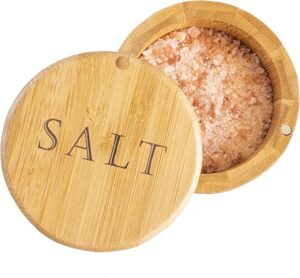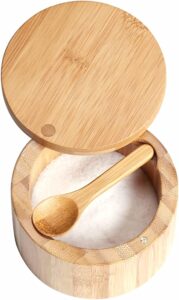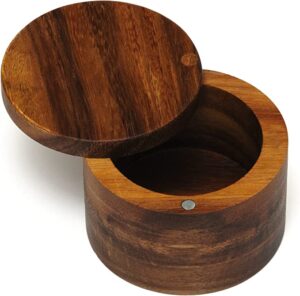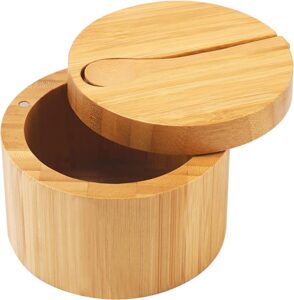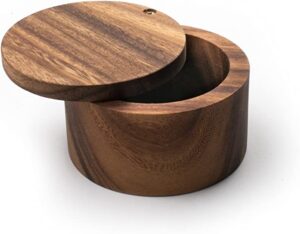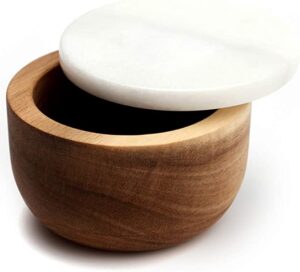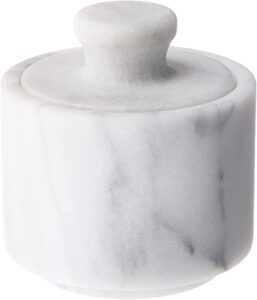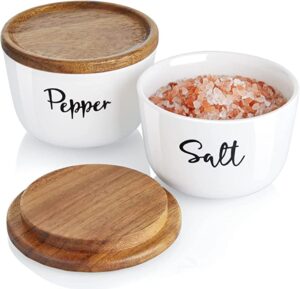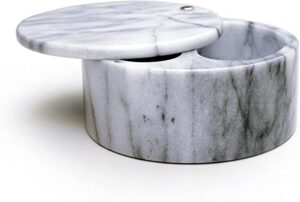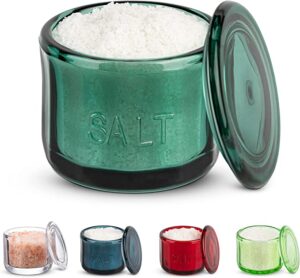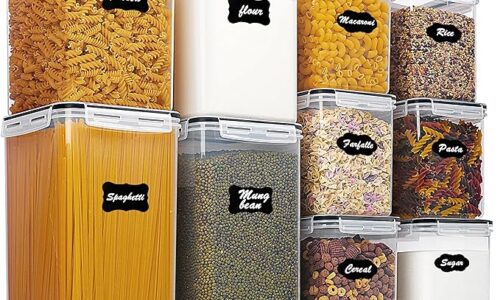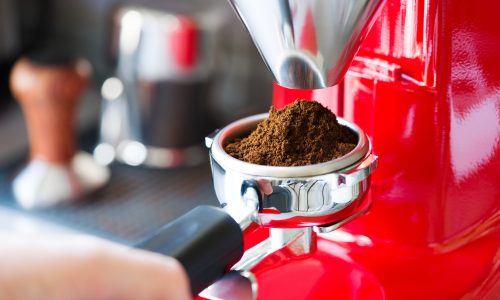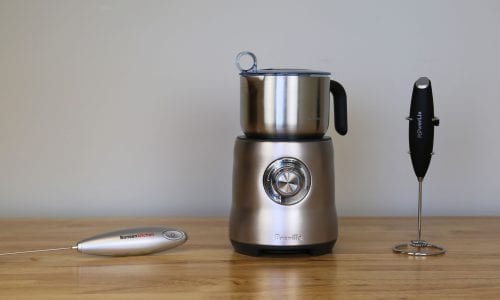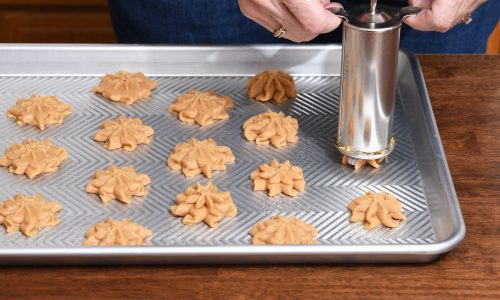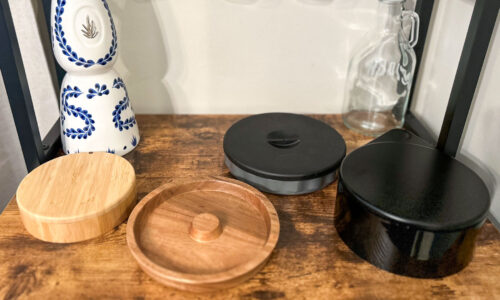The Best Salt Cellar

Our Review Process
Don't Waste Your Money is focused on helping you make the best purchasing decision. Our team of experts spends hundreds of hours analyzing, testing, and researching products so you don't have to. Learn more.
Our Picks For The Top Salt Cellars
- 1. Totally Bamboo Engraved Magnetic Swivel Lid Bamboo Salt Cellar
- 2. KITCHENDAO Bamboo Swivel Magnetic Lid Built-In Spoon Salt Cellar
- 3. Lipper International Acacia Wood Swivel Cover Salt Cellar
- 4. Ironwood Gourmet Acacia Wood Swivel Lid Appalachian Salt Cellar
- 5. HTB Swivel Magnetic Lid Bamboo Salt Cellar With Mini Spoon
- 6. jalz jalz Modern Natural Acacia & Marble Lid Salt Cellar
- 7. Fox Run Versatile Round Lidded Marble Salt Cellar
- 8. DAYYET Stackable Acacia Wood Lid Salt & Pepper Cellar Set
- 9. RSVP International Swivel Lid Dual Compartment Marble Salt Cellar
- 10. KooK Embossed Pressed Glass LIdded Round Salt Cellar
With a capacity of up to 6 ounces, this salt cellar is made from natural bamboo. The word “Salt” is scrawled across the lid, available in your choice of fonts. The lid includes a magnetic lock that allows it to easily swing open and seal shut again.
Attractive DesignChoose from a variety of engraving styles on the lid, which features the word “Salt” to make it easy to identify what’s inside.
This salt cellar is made from eco-bamboo with a mineral oil coating for a long-lasting solution. The included serving spoon stores handily beneath the lid in a carved-out section to make sure it’s always ready to go. The swivel lid has a magnet to ensure it stays in place and out of the way until you’re ready to slide it back into place.
Super ConvenientA built-in serving spoon ensures you’re always ready to dispense salt with this convenient option.
Durable acacia wood gives this salt cellar a build that will last. The color is a darker wood to give it a classic look, and it measures 3½ with a diameter of 2½, making it ideal for salt or any other type of seasoning you want to store. It has a swivel cover that can be operated with one hand for use while you’re cooking.
Understated ClassThe dark finish of this salt cellar helps it blend well with any décor.
This extra-large salt cellar can hold up to 8 ounces of salt or other seasonings. It comes in a light-colored bamboo with a matching bamboo serving spoon that stores under the lid. A magnet locks the lid into place between uses to protect the items inside.
Versatile OptionLight-colored wood makes this salt cellar a great fit for any décor, broadening its uses.
Buying Guide
Salt shakers have become kitchen standards in recent years, but there are benefits to an old-fashioned salt container. These containers go by two different names: salt cellar and salt pig. They each serve the same purpose, though. They keep salt tucked away under a lid, where they resist moisture and contaminants.
The best thing about a salt cellar is that it doesn’t limit you to grain sizes. When you’re shopping for salt, you’ll see fine, kosher, coarse and powder, but traditional salt shakers limit you to fine unless you want to grind the salt. A salt cellar is a container with a lid, so you can fill it with any size you want.
But you’ll find salt cellars in three different material types, each with its own benefits:
- Wood: The most popular type of salt cellar, wood naturally resists moisture, helping keep the interior contents dry. This type of cellar may be made from a variety of woods, each varying in durability, but overall, this type of container holds up well because it can easily survive being dropped and banged around.
- Ceramic: Made from clay, this type of salt cellar typically features fun designs. They’re usually less expensive than porcelain, but the lid doesn’t always seal well enough to keep moisture out.
- Porcelain: Another popular option is porcelain, which is made from clay fired at a higher temperature, giving it more durability than ceramic. Porcelain can be easier to clean than wood or ceramic. However, you’ll need to check the seal to ensure it will keep moisture at bay.
It’s important to look at a salt cellar’s protection against moisture, though. Salt can tend to absorb moisture in the surrounding air, which is why you’ll sometimes see grains of rice in salt shakers. The rice also keeps the salt from clumping, letting you enjoy a fresh seasoning experience each time.
What to Look For
- Cleanup can be a challenge with wood salt cellars. When you do need to clean it, wipe it down with a wet cloth. Don’t soak it in water or run it through the dishwasher.
- If you’re going for a wooden salt cellar, pay close attention to the type of wood. Bamboo and acacia are particularly popular thanks to their durability and moisture resistance.
- Consider the way the lid attaches to the container. Some have magnets that hold them in place while also allowing you to slide them out of the way with one hand.
- Salt cellars are typically fairly small, but make sure you’re getting the capacity you need. You’ll need to balance that against the space they’ll take up. Whether you’re storing it on your table or one of your counters, you’ll want to make sure it fits into your existing setup.
- You’ll need to be able to reach your thumb and fingers inside to grab a pinch of salt. Keep that in mind. The base should be wide enough to comfortably accommodate that.
- The duration of your salt will depend on the type. Iodized salt has an expiration date of typically about five years. Regular salt won’t expire, though.
- It’s important to avoid contaminating the salt inside your cellar. Oils and sauces from your fingertips can shorten salt’s shelf life and introduce moisture that you then seal inside. This could cause the clumping that you’re trying to avoid.
- Handcrafted construction can add that extra touch while also boosting your salt cellar’s durability.
- If you prefer to dole out your salt with a small spoon, look for a salt cellar that has one included. Some fit snugly beneath the lid to seal them in with the salt and ensure they’re always ready. This will help keep you from accidentally inserting a wet spoon and introducing moisture to the internal contents.
More to Explore
Long before salt shakers came salt cellars, which date all the way back to Ancient Rome. During that era, salt was considered a prized possession, and the containers that held it served as status symbols. At banquets, a salt cellar was placed in front of prominent guests to acknowledge their affluence.
By the Victorian era, salt cellars were more common, and each dinner guest would have one. Silver was a popular material for salt cellars, but salt can damage silver. For that reason, glass liners were developed that could serve as a protective layer between the silver and the contents of the cellar. If a vintage cellar doesn’t have the glass insert, you’ll need to empty the contents and carefully wipe the interior between every use.

